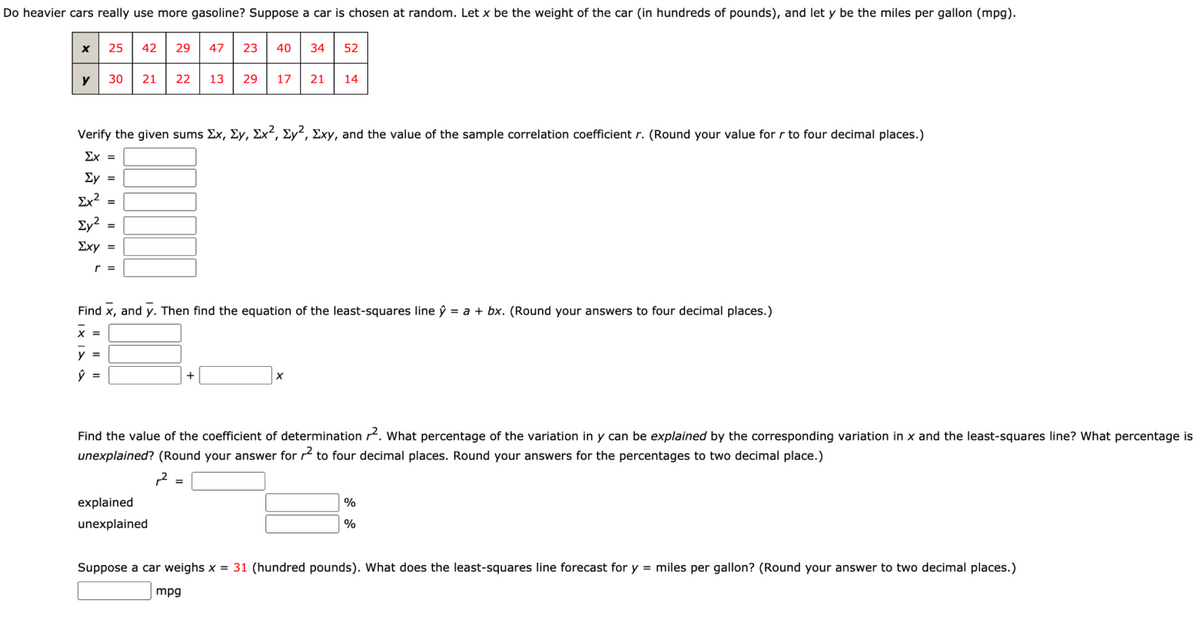o heavier cars really use more gasolline? Suppose or pounds), and 25 42 29 47 23 40 34 52 30 21 22 13 29 17 21 14 Verify the given sums Ex, Ey, Ex², Ey², Exy, and the value of the sample correlation coefficient r. (Round your value for r to four decimal places.) Ex = Ey = Ex? = Ey? = Exy = Find x, and y. Then find the equation of the least-squares line ŷ = a + bx. (Round your answers to four decimal places.) y = Find the value of the coefficient of determination 2. What percentage of the variation in y can be explained by the corresponding variation in x and the least-squares line? What percentage unexplained? (Round your answer for to four decimal places. Round your answers for the percentages to two decimal place.) explained % unexplained % Suppose a car weighs x = 31 (hundred pounds). What does the least-squares line forecast for y = miles per gallon? (Round your answer to two decimal places.) mpg
o heavier cars really use more gasolline? Suppose or pounds), and 25 42 29 47 23 40 34 52 30 21 22 13 29 17 21 14 Verify the given sums Ex, Ey, Ex², Ey², Exy, and the value of the sample correlation coefficient r. (Round your value for r to four decimal places.) Ex = Ey = Ex? = Ey? = Exy = Find x, and y. Then find the equation of the least-squares line ŷ = a + bx. (Round your answers to four decimal places.) y = Find the value of the coefficient of determination 2. What percentage of the variation in y can be explained by the corresponding variation in x and the least-squares line? What percentage unexplained? (Round your answer for to four decimal places. Round your answers for the percentages to two decimal place.) explained % unexplained % Suppose a car weighs x = 31 (hundred pounds). What does the least-squares line forecast for y = miles per gallon? (Round your answer to two decimal places.) mpg
Algebra & Trigonometry with Analytic Geometry
13th Edition
ISBN:9781133382119
Author:Swokowski
Publisher:Swokowski
Chapter10: Sequences, Series, And Probability
Section10.8: Probability
Problem 38E
Related questions
Question
100%

Transcribed Image Text:Do heavier cars really use more gasoline? Suppose a car is chosen at random. Let x be the weight of the car (in hundreds of pounds), and let y be the miles per gallon (mpg).
25
42
29
47
23
40
34
52
y
30
22
13
29
17
21
14
Verify the given sums Ex, Ey, Ex², Ey², Exy, and the value of the sample correlation coefficient r. (Round your value for r to four decimal places.)
Σχ=
Ey
%3D
Ex?
Ey?
Σχy
Find x, and y. Then find the equation of the least-squares line ŷ = a + bx. (Round your answers to four decimal places.)
x =
y =
+
Find the value of the coefficient of determination r. What percentage of the variation in y can be explained by the corresponding variation in x and the least-squares line? What percentage is
unexplained? (Round your answer for r to four decimal places. Round your answers for the percentages to two decimal place.)
%3D
explained
%
unexplained
%
Suppose a car weighs x = 31 (hundred pounds). What does the least-squares line forecast for y = miles per gallon? (Round your answer to two decimal places.)
mpg
21
I|||
Expert Solution
This question has been solved!
Explore an expertly crafted, step-by-step solution for a thorough understanding of key concepts.
This is a popular solution!
Trending now
This is a popular solution!
Step by step
Solved in 2 steps

Knowledge Booster
Learn more about
Need a deep-dive on the concept behind this application? Look no further. Learn more about this topic, statistics and related others by exploring similar questions and additional content below.Recommended textbooks for you

Algebra & Trigonometry with Analytic Geometry
Algebra
ISBN:
9781133382119
Author:
Swokowski
Publisher:
Cengage

Algebra & Trigonometry with Analytic Geometry
Algebra
ISBN:
9781133382119
Author:
Swokowski
Publisher:
Cengage